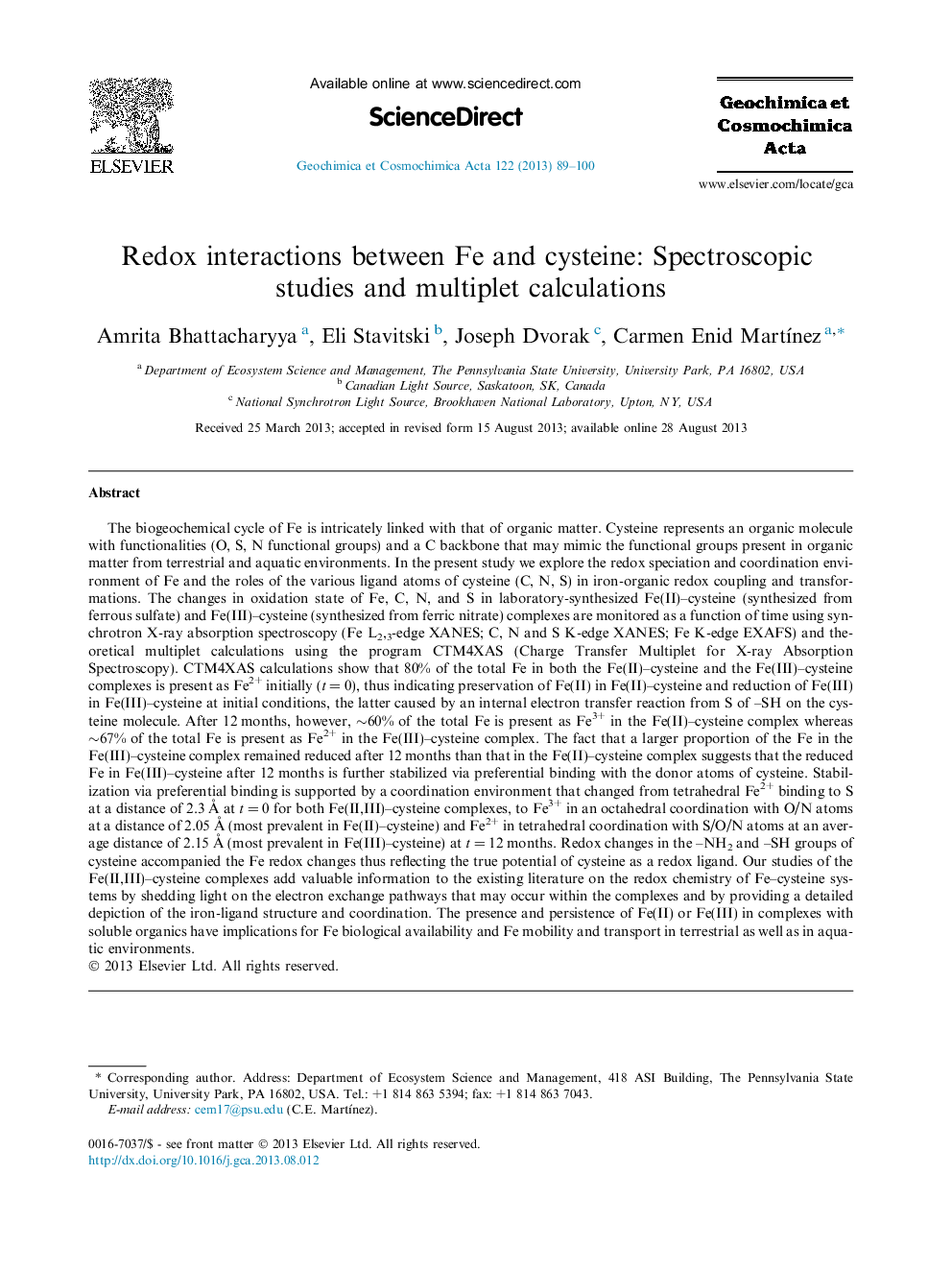| کد مقاله | کد نشریه | سال انتشار | مقاله انگلیسی | نسخه تمام متن |
|---|---|---|---|---|
| 6438799 | 1638035 | 2013 | 12 صفحه PDF | دانلود رایگان |
عنوان انگلیسی مقاله ISI
Redox interactions between Fe and cysteine: Spectroscopic studies and multiplet calculations
دانلود مقاله + سفارش ترجمه
دانلود مقاله ISI انگلیسی
رایگان برای ایرانیان
موضوعات مرتبط
مهندسی و علوم پایه
علوم زمین و سیارات
ژئوشیمی و پترولوژی
پیش نمایش صفحه اول مقاله

چکیده انگلیسی
The biogeochemical cycle of Fe is intricately linked with that of organic matter. Cysteine represents an organic molecule with functionalities (O, S, N functional groups) and a C backbone that may mimic the functional groups present in organic matter from terrestrial and aquatic environments. In the present study we explore the redox speciation and coordination environment of Fe and the roles of the various ligand atoms of cysteine (C, N, S) in iron-organic redox coupling and transformations. The changes in oxidation state of Fe, C, N, and S in laboratory-synthesized Fe(II)-cysteine (synthesized from ferrous sulfate) and Fe(III)-cysteine (synthesized from ferric nitrate) complexes are monitored as a function of time using synchrotron X-ray absorption spectroscopy (Fe L2,3-edge XANES; C, N and S K-edge XANES; Fe K-edge EXAFS) and theoretical multiplet calculations using the program CTM4XAS (Charge Transfer Multiplet for X-ray Absorption Spectroscopy). CTM4XAS calculations show that 80% of the total Fe in both the Fe(II)-cysteine and the Fe(III)-cysteine complexes is present as Fe2+ initially (t = 0), thus indicating preservation of Fe(II) in Fe(II)-cysteine and reduction of Fe(III) in Fe(III)-cysteine at initial conditions, the latter caused by an internal electron transfer reaction from S of -SH on the cysteine molecule. After 12 months, however, â¼60% of the total Fe is present as Fe3+ in the Fe(II)-cysteine complex whereas â¼67% of the total Fe is present as Fe2+ in the Fe(III)-cysteine complex. The fact that a larger proportion of the Fe in the Fe(III)-cysteine complex remained reduced after 12 months than that in the Fe(II)-cysteine complex suggests that the reduced Fe in Fe(III)-cysteine after 12 months is further stabilized via preferential binding with the donor atoms of cysteine. Stabilization via preferential binding is supported by a coordination environment that changed from tetrahedral Fe2+ binding to S at a distance of 2.3 Ã
at t = 0 for both Fe(II,III)-cysteine complexes, to Fe3+ in an octahedral coordination with O/N atoms at a distance of 2.05 Ã
(most prevalent in Fe(II)-cysteine) and Fe2+ in tetrahedral coordination with S/O/N atoms at an average distance of 2.15Â Ã
(most prevalent in Fe(III)-cysteine) at t = 12 months. Redox changes in the -NH2 and -SH groups of cysteine accompanied the Fe redox changes thus reflecting the true potential of cysteine as a redox ligand. Our studies of the Fe(II,III)-cysteine complexes add valuable information to the existing literature on the redox chemistry of Fe-cysteine systems by shedding light on the electron exchange pathways that may occur within the complexes and by providing a detailed depiction of the iron-ligand structure and coordination. The presence and persistence of Fe(II) or Fe(III) in complexes with soluble organics have implications for Fe biological availability and Fe mobility and transport in terrestrial as well as in aquatic environments.
ناشر
Database: Elsevier - ScienceDirect (ساینس دایرکت)
Journal: Geochimica et Cosmochimica Acta - Volume 122, 1 December 2013, Pages 89-100
Journal: Geochimica et Cosmochimica Acta - Volume 122, 1 December 2013, Pages 89-100
نویسندگان
Amrita Bhattacharyya, Eli Stavitski, Joseph Dvorak, Carmen Enid MartÃnez,